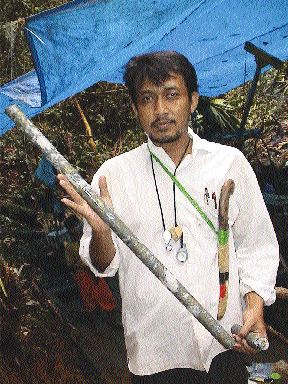There’s persistence, then there’s
Kalimantan has maintained an exploration project in the middle of Kalimantan from the 1990s. Its contract of work (CoW) is held by an Indonesian subsidiary, Kalimantan Surya Kencana, in which Kalimantan Gold owns a 75% interest. Private Kalimantan Investment Corporation, the largest shareholder of Kalimantan Gold, owns the other 25% of Kalimantan Surya Kencana.
The contract area is 1,292 sq. km and sits near the head of the Baroi and Kahayan Rivers, very near the middle of Kalimantan. The district capital, Palangkaraya, is about 200 km to the south.
Most of the company’s recent effort has been concentrated on a porphyry complex at Baroi, in the southwestern part of its CoW. There, four separate copper propects — the Central, South, East, and Far East zones — have been mapped and partly drilled.
Work in the 1980s and 1990s by Australian geologists Mansur Geiger (now the company’s vice-president of exploration) and Mathew Mayberry turned up boulders mineralized with copper and gold downstream from the Baroi prospects. After logging roads opened up the area in late 2002, mapping and sampling outlined an area about 6 km by 5 km including the four Baroi zones.
Baroi’s Far East zone has seen most of the work, following gephysical surveys that suggested the main intrusive centre might be there. A 22-hole drill program in late 2003 confirmed copper-gold mineralization at shallow depths, with one intersection cutting 83 metres grading 2.6% copper and 0.22 gram gold per tonne, with silver, zinc and lead credits. That hole turned out to have been drilled downdip on a vein — exaggerating the size of the mineralized zone — but indicated that there were abundant quartz-sulphide veins in dilatant openings in the area’s main southeast-striking shear zone.
A March 2004 induced-polarization (IP) survey, over an area 2.9 by 1.6 km in the Far East zone, indicated that chargeable zones continued eastward. At the same time, geological mapping 1.3 km east of the Far East zone revealed disseminated copper mineralization over an area 1.5 km long by 600 metres wide.
An expanded IP survey, covering the area farther to the east, showed high-chargeability values of around 300 metres deep below the new mineralization, accompanied by a conductive zone at depth. The IP and resistivity results coincided with magnetic anomalies found in earlier airborne geophysics, with a zone of high magnetic susceptibility surrounded by a zone of low susceptibility, a pattern common around porphyry copper mineralization.
Kalimantan’s most recent drilling seems to confirm that if the big mineralized body is anywhere, it is to the southeast. A hole drilled about 300 metres northeast of the previously mapped shear zone, BF-030, intersected 41.9 metres near the surface grading 3.18% copper and 101 grams silver per tonne, with 0.99% lead, 1.85% zinc, and 0.16 gram gold. It also hit a 7-metre zone at about 92 metres down-hole, grading 1.39% copper and 71 grams silver per tonne, with minor lead, zinc and gold values.
Two other holes drilled from a collar about 200 metres northwest of BF-030 encountered strongly altered rocks with weak zinc mineralization.
In the southeastern part of the contract area, the Beruang Kanan porphyry-copper prospect is at a much earlier stage of exploration. Beruang has two identified copper showings: the Main zone, which saw 25 drill holes bewtween 1998 and 2001, and the South zone, which has been mapped and sampled on surface with only limited drilling. Between the two zones, both of which are identified as dacite-porphyry intrusive centres, are polymetallic showings that appear to be marginal mineralization to the main porphyry system.
Beruang’s Main zone consists of a main northwest-striking body of copper mineralization in altered dacite tuff, where the richest intersection ran 0.59% copper over 167 metres. The mineralization is mainly chalcopyrite at depth, but a supergene zone of covellite and chalcocite exists near surface.
Its surface expression is a zone measuring 1.5 by 1 km with 0.1% copper or more in rock chips, displaying intense phyllic alteration. In the “core” of the zone the alteration grades up to an advanced argillic assemblage, with clays and sericite.
There are northeast-striking zones of zinc and lead showings in a “halo” around the Main zone; drilling intersected shears and sheeted veins carrying up to 2.8% lead and 5.8% zinc, with 58 grams silver, 0.7 gram gold, and 0.17% copper, over a core length of 16 metres.
At Beruang South, a 1-km-long central zone strikes northeast through stongly altered dacite tuff. It has been defined mainly through soil geochemistry, which revealed an area about 800 by 400 metres with copper concentrations over 350 parts per million (350 grams per tonne) in overlying soils.
Rock sampling confirmed the soil results, returning values of up to 1% copper and 15 grams gold per tonne.
Between the two zones, the rock types are a mixture of dacite porphyry and volcanic dykes, hosted in felsic fragmental rocks and derived sediments. Geological mapping and rock sampling have confirmed lead-zinc-silver mineralization on surface, with the best sample assaying 3,440 grams silver per tonne, with 26% lead, 35% zinc, 3% copper and 1 gram gold per tonne.
The contract area also hosts several other copper-gold prospects, the most promising of which at this stage seems to be Mansur, 10 km northwest of Baroi. There, a porphyry system about 1 km in diameter is exposed at surface.
In May, Kalimantan completed private placements to raise slightly more than $400,000 for work on Baroi, issuing just under 800,000 shares(each with half a warrant attached). The shares become eligible for trading in September, and the warrants are exercisable until November 2005 at 70.
The company has 31.8 million shares outstanding.


Be the first to comment on "Kalimantan Gold pins hopes on the east"